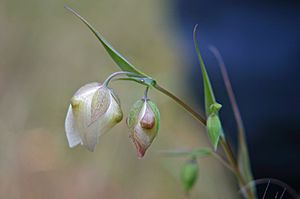Calochortus albus facts for kids
Quick facts for kids Calochortus albus |
|
|---|---|
 |
|
| Scientific classification | |
| Genus: |
Calochortus
|
| Species: |
albus
|
Calochortus albus, also known as the fairy lantern or globe lily, is a beautiful flower species. It belongs to the Calochortus genus and the Liliaceae family, which includes lilies. People also call it the white fairy lantern, pink fairy lantern, lantern of the fairies, white globe lily, white globe-tulip, alabaster tulip, Indian bells, satin bells, snowy lily-bell, and snow drops.
Contents
What Does the Fairy Lantern Look Like?
This plant is found in many places and can look a bit different depending on where it grows. It blooms in winter and spring. After flowering, it rests until the autumn rains begin.
Plant Size and Stems
- Height: These plants usually grow to be about 20 to 80 centimeters tall.
- Stems: Their stems stand up straight or arch gently. They are thin, often have a whitish-blue coating (glaucous), and can be simple or have branches.
Leaves of the Fairy Lantern
The fairy lantern has two main types of leaves:
- Basal Leaves: One long leaf grows from the base of the plant. It can be 20 to 70 centimeters long and 1 to 5 centimeters wide. These leaves are shiny and stay on the plant during blooming.
- Stem Leaves: There are also 2 to 6 leaves on the stem itself. These leaves are shaped like spears (lanceolate) or narrow lines (linear) and are 5 to 25 centimeters long.
Fairy Lantern Flowers
The flowers of the fairy lantern are truly special!
- Flower Clusters: Flowers grow in groups, from one to many. Small, spear-shaped leaves (bracts) are usually found in pairs below the flowers.
- Flower Appearance: Each flower is delicate and hangs downwards, looking like a closed orb. They are usually 2 to 3 centimeters wide. Their color can range from pearly white to pink, deep pink, or even almost wine-red. Sometimes, they might have a greenish tint.
- Blooming Time: You can see these flowers from late March through April, May, June, and into early July.
- Petals and Sepals: Each flower has three petals and three sepals. The sepals are like small leaves that protect the petals.
- Sepals: These are usually shorter than the petals and can be white, green, or rosy red.
- Petals: The three petals are often elliptic and slightly overlap. They feel satiny and are usually closed at the tip. They might have hints of green, copper, pink, lavender, or purple on the outside, especially near their base.
- Nectary: Inside the flower, there's a crescent-shaped area called the nectary. This is where the plant makes nectar, a sweet liquid that attracts pollinators. It has small, fringed membranes with white or yellow hairs.
- Stamens: The stamens are the parts of the flower that produce pollen. They are short, white to light pink, and about 4 millimeters long.
Fruit and Seeds
- Fruit: After the flower blooms, it forms a nodding, oval-shaped fruit. This fruit is a capsule with three clear wings and measures 2 to 4 centimeters long.
- Seeds: Inside the fruit are dark brown, irregularly shaped seeds.
Where Does the Fairy Lantern Live?
Calochortus albus is found in many different places. It likes shady or open woods, scrub areas, and grasslands that get some sun. You can often find it in rocky spots. It grows in many plant communities below 5,000 feet (about 1,500 meters) or 2,000 meters, including foothill woodlands, yellow pine forests, and chaparral.
Where Can You Find the Fairy Lantern?
This flower grows throughout the southern two-thirds of California, USA. You can find it in:
- The foothills of the Sierra Nevada mountains.
- The southern coast ranges.
- The peninsular ranges, stretching from Baja California in Mexico, up through San Diego, to the San Francisco Bay Area.
- It also extends into northern California and the California Channel Islands.
How to Grow Fairy Lanterns
If you want to grow Calochortus albus, here are some tips:
- Light: It likes full sun to partial shade.
- Soil: This plant can adapt to different soils, but it prefers soil that drains water well.
- Water: Fairy lanterns can handle dry conditions. In nature, they get little to no rain when they are resting. When you grow them, give them regular water during their growing season. Once their leaves start to turn yellow, the bulbs need to dry out. Too much water or poor drainage can harm the bulbs.
- Climate Zone: This plant is quite tough and can survive cold temperatures down to about -18°C (0°F), and possibly even -23°C (-10°F). It grows well in USDA zones 9-10.
How Do Fairy Lanterns Reproduce?
Calochortus albus grows only from seeds. It does not produce small bulbs (bulbils) or offsets (new plants growing from the side). The seeds do not need any special treatment to sprout. If you plant seeds, you can expect the flowers to bloom in about 3 or 4 years.
Sometimes, Calochortus albus can mix with another species called Calochortus monophyllus to create new hybrid plants.
What Do the Names Mean?
- Albus: The word albus comes from Latin and means 'white' or 'bright'. This makes sense because many of these flowers are white.
- Calochortus: This name comes from Greek words that mean 'beautiful grass'. This refers to the plant's leaves, which look like grass.
Images for kids
See also
 In Spanish: Calochortus albus para niños
In Spanish: Calochortus albus para niños



